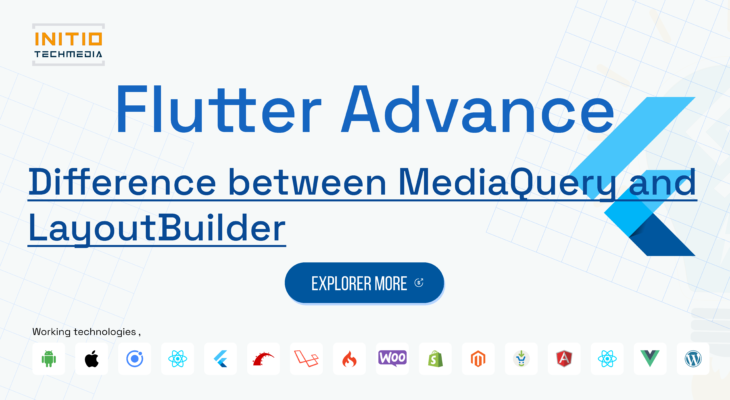Leading Mobile & web Development company which is providing Ready to publish apps & on demands application in Global Bussiness.
- 908, B Square 2, Ambli Rd, near Hotel Double tree Hilton, Vikram NagarAhmedabad-380054, Gujarat, India
- (+91) 8758432204Give us a call
- contact@initiotechmedia.com24/7 online support

Difference between MediaQuery and LayoutBuilder
- payal patel
- May 23, 2023
- 0
MediaQuery and LayoutBuilder are both classes in Flutter that provide information about the layout and constraints of the app’s UI. However, they serve different purposes and have different use cases.
MediaQuery:MediaQueryis a class that provides access to various properties related to the device’s screen, such as its size, orientation, and pixel density. It allows you to retrieve information about the device’s screen and adjust the UI accordingly. It is primarily used for creating responsive designs and adapting the layout based on the available screen space.
Some commonly used properties of MediaQuery include:
MediaQuery.of(context).size: Returns the size of the device’s screen.MediaQuery.of(context).orientation: Returns the orientation of the device (portrait or landscape).MediaQuery.of(context).devicePixelRatio: Returns the device’s pixel density.
You can use MediaQuery to build UIs that dynamically adjust to different screen sizes and orientations. For example, you can use it to set different font sizes, spacing, or layouts based on the available screen space.
LayoutBuilder:LayoutBuilderis a widget that helps you build a UI based on the parent widget’s constraints. It provides a builder function that receives the constraints as a parameter and returns a widget based on those constraints. It allows you to create widgets that adapt their size and layout based on the available space within their parent.
The builder function of LayoutBuilder receives a BuildContext and a BoxConstraints object. The BoxConstraints represents the constraints that the parent widget has set on its child. It includes properties like minimum and maximum width and height.
By utilizing LayoutBuilder, you can create widgets that respond to changes in their parent’s constraints. For instance, you can adjust the size or position of child widgets within a layout based on the available space.
In summary, while MediaQuery provides information about the device’s screen and is useful for creating responsive designs, LayoutBuilder helps you build widgets that adapt their size and layout based on the constraints imposed by their parent widget. They can be used together to create flexible and responsive UIs in Flutter.
- Tags:
- Flutter 2.0
- flutter 2023
- Flutter 3.0
- Flutter advance
- Flutter App developer
- Flutter app development
- flutter architechture
- Flutter bloc
- flutter developer
- Flutter development
- Flutter Libraries
- flutter machine learning
- Flutter Ui
- Flutter Widget
- Hire flutter developers
- IOS
- mobile app development
- Mobile app with AI #AR
WhatsApp us

